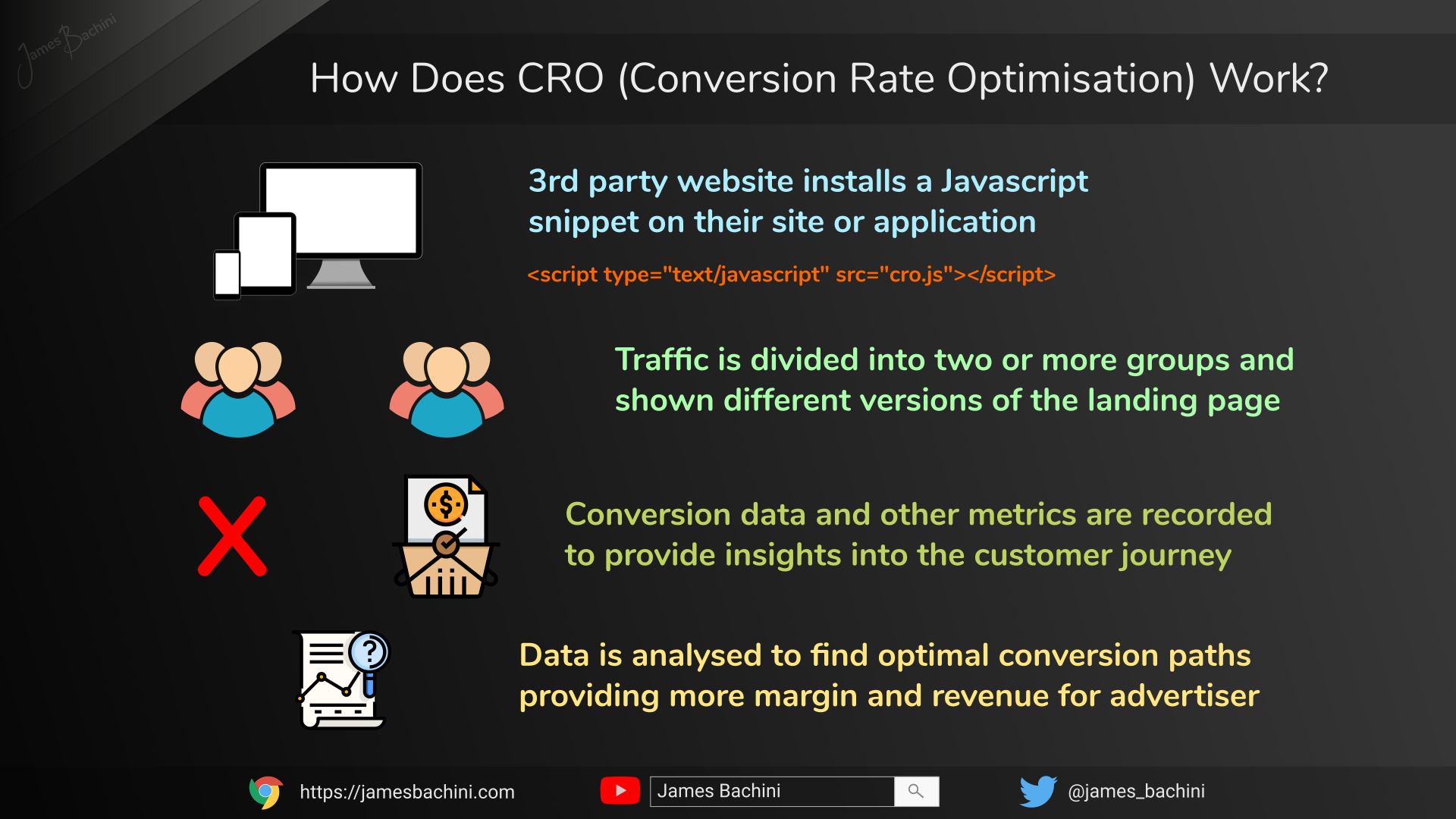This article is part of a free online course where you can learn digital marketing.
Conversion rate optimisation or CRO is the process of making a website, landing page or app convert more visitors into leads and customers.
- What is CRO and do I need it?
- What is the Average Improvement to Conversion Rate?
- How does CRO work?
- Do I Need a CRO Consultant or Agency?
- CRO Software
- The Conversion Rate Optimisation Process
- AB Testing vs MV Testing & When To Use Each
- 26 CRO Ideas To Test
- Creating a Conversion Rate Optimisation Plan
- Forming Customer Journey Insights
- The Golden Rule For CRO

What is CRO and do I need it?
Conversion rate optimisation improves the performance of a web property continuously and incrementally over time.
A simple and overly used example is a call to action button on a website. This may be a subscribe button or an add to cart button, something that makes a difference to the conversion process.
We can come up with a hypothesis that changing the button color from green to orange will make it stand out more and get more clicks.
Code would then be placed on the website to “split test” the two coloured buttons. Half of the visitors would see a green button and half would see an orange button. Clicks on the buttons would be tracked alongside key performance metrics such as leads and sales.
After a set amount of visitors we could analyse the results and validate our original hypothesis. While carrying out multiple tests we can learn about the customer’s journey and devise new hypotheses to be tested in the future.
What is the Average Improvement to Conversion Rate?
I’ve seen 25% quoted as the industry standard. It really depends widely on how good your site is to start with. Leading online businesses will change agencies every year or two to try and squeeze an extra 1% out of their conversion rate and that is seen as a success. For a site that’s never had any optimisation or testing done before it’s not unusual to see conversion rates double.
The biggest CRO improvement I ever heard of was for an e-commerce store that had a registration form which users needed to complete before checkout. Removing the registration form increased sales on the site by $300,000,000 USD a year and by now would have totaled over $1 billion in additional revenue.
CRO takes time however and it’s a continuous process. Changing one button colour isn’t likely to make a 100% difference to your return on ad spend. However changing the angle, the squeeze page, the auto-responder series, adding an upsell, improving page load times and many other things as well might get the results you need.
How does CRO work?
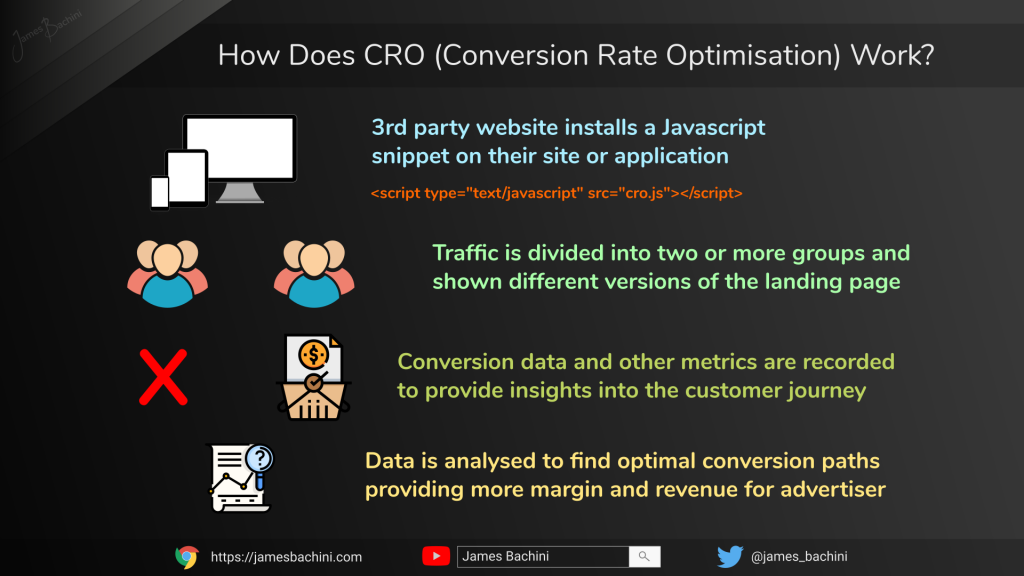
Conversion rate optimisation works by tracking data and analysing that data to draw conclusions on your conversion funnel.
When I do CRO on a 3rd party website or app I install a Javascript snippet onto the site which executes on page load.
The Javascript will then make any alterations to AB test elements on the page. Some tests will have more than 2 variations and there could be multiple tests on a single page known as multivariate or MV testing.
A random number is calculated between 0 and 1 and if that number is above 0.5 variation A is shown, if below then variation B is shown. The variation is tracked in the browsers local storage.
Additionally the Javascript code will add conversion events to the page, app or site. So for most sites revenue is the most significant KPI (Key performance indicator). This will be tracked alongside, time on site, clicks, social shares, email leads, scrolling behaviour and any other micro conversions that can be processed.
Whenever a conversion is fired the localStorage data for the variation tests will be fired back to the datastore and the cro data will be safely logged in cloud storage.
CRO is not an instant process; it will take time to gain enough visitors, leads and sales to make accurate assessments of the data. More busier sites can be tested and optimised faster than sites with fewer visitors.
At regular intervals the data will be analysed to decide if we can validate a hypothesis. Tests that improved conversion rate consistently get closed and hard coded into the site or reiterated for further improvements.
Do I Need a CRO Consultant or Agency?
If the above didn’t make a lot of sense then quite likely yes. CRO is a complex activity that requires a complex and specialist skill set.
The best CRO consultants and agencies are experts in:
- UX/UI
- Design
- Analytics
- Conversion Funnels
- E-commerce
- Coding & Development
- Copywriting
- Consumer Psychology
If you have all these skills then you should go it alone as there’s no better way to gain insights into your own customers behaviour.
For everyone else there are two options, pre-built CRO software packages or hiring a consultant/agency.
I’ll discuss CRO software in the next chapter however if your company has significant revenues then a consultant or agency may be a good investment. Agencies and consultants are expensive and you need to be doing, or planning on doing, enough revenue per year through your website/app to make it cost effective.
CRO Software
While I’d always recommend storing and analysing the data yourself if possible, here are some of the platforms that can take care of the tracking side of CRO.
Google Optimize

I have used this in the past and have had mixed experiences with it. It’s probably the most popular software for A/B testing but it’s not particularly intuitive or quick to load the tests. Also the visual editor isn’t good and breaks some sites.
There is a free tier which could be useful to anyone on a budget that just wants to dip their toe in the water with CRO.
https://marketingplatform.google.com/intl/en_uk/about/optimize/
Optimizely
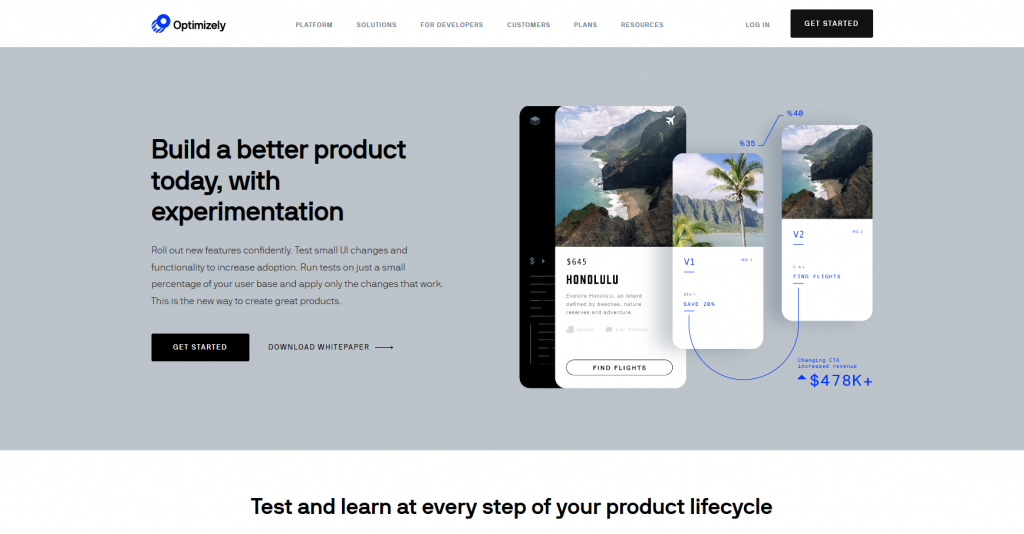
Optimizely is a SaaS startup which started off as a dedicated AB testing suite I believe. Their platform includes an nocode visual editor like Google’s for web based testing.
The product has grown from an optimization suite to including a lot of tools aimed at mobile app developers.
https://www.optimizely.com/platform/experimentation/
VWO

VWO is similar to Optimizely but slightly simpler to use. They have some nice features such as CRO planner and customer feedback solutions.
VWO Testing suite starts at $199/month
Which should I use?
I don’t think any of these solutions are perfect. If you have the ability, then you should track the data yourself which will give you more flexibility and insights into the process. If not I’d recommend hiring a consultant that can not only set up the tracking but also advise on the types of tests you should be running.
The Conversion Rate Optimisation Process
In this section we will look at the process of CRO from start to finish.
Define Key Performance Indicators
The first thing we need to do is work out some metrics. How will we define what is a successful vs unsuccessful test. Start with the key performance indicators. What metric on your site will make the most difference to your business over the next year?
It could be the number of email leads, amount of sales revenues or the number of social shares.
Conversion events can be broken down to site, page and even test level. While a button click may not be important for the site overall it will be worth tracking for any tests that affect that page.
There are no limits to what you can test. Micro conversions can be set up to track page scrolls, time on site, social shares, form stage completions. The possibilities are endless and the more data you have the more insight you’ll get into how customers react to your tests.
Setup Tracking
At this stage tracking will be set up to log the conversion and CRO data. Normally each time a customer completes a conversion event a pixel will be fired which logs a conversion on the backend datastore.
Sites with lots of traffic should take data and load volumes into account and plan server architecture accordingly. Datasets on large sites can grow quickly and become difficult to manage and analyse without pre-planning.
Visitor Behaviour Analysis
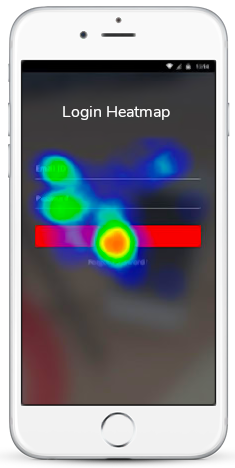
At this point consider if the conversion data will be enough to make informed decisions. Could adding customer feedback buttons, heatmaps, site surveys and chatbots provide valuable information.
Standard A/B tests will provide the metrics but understanding the data is key to CRO. If you can gain some qualitative data to shine a light on the quantitative test data then this is the point when that should be set up.
Deciding What To Test
Testing should start out broad with the parts of the funnel that will make the biggest impact
If your funnel includes a squeeze page and a follow up sales page, then the squeeze page will provide the low hanging fruit for CRO. This is partly because objects higher up the funnel will receive more traffic and be easier/quicker to optimise. It’s also partly because of the compounding effect that changes here will have further down the funnel. If you can double your conversion rate on the squeeze page then you’ll have twice the leads, traffic and revenue to continue testing other parts of the funnel.
For example a direct response campaign we might test five completely different landing pages to start with. Once there is enough data to give a clear indication of the best performing lander(s) we will take one or two of these and do variations on the theme to further improve the conversion rate.
Make big changes, try new angles, get creative.
Validating Hypothesis
It is essential not to rush your tests and make hasty decisions. It’s easy to cut tests too quickly when the early data backs up your hypothesis but in reality all you are seeing is variance. Without adequate traffic and data it’s a waste of time.
The more tests you run consecutively the more data needed to validate each test. One test can affect another test and it’s important to wait for clear outcomes in the results. I’ve run AB tests in the past where I’ve considered cutting it right before a massive swing in the results.
The factors that need to be met should be laid out in advance as part of the conversion rate optimisation plan. It can be flexible such as, a conclusive test will be terminated at:
- 1000 conversions @ 5% conversion rate difference
- 10000 conversions @ 3% conversion rate difference
- 20000 conversions @ 2% conversion rate difference
- 50000 conversions @ 1% conversion rate difference
The more important a test the longer it should run. Testing a button colour isn’t the same as testing the core value proposition of your company.
Making Data Driven Decisions
Once you have the test data in place it’s easy enough to close off the test and hard code in changes, assuming it was successful. Failed tests just get closed off and we move on to the next thing.
It’s perfectly normal to have failed tests. Not even the top CRO agencies on the planet get it right all the time. When working on websites or apps that have already received a lot of optimisation work a win percentage of 50%+ is great. Failed tests don’t hurt your long term conversion rate but successful ones make a difference moving forwards.
The data is always right, there is no point hanging on to theory if the data is going against your original hypothesis. Come up with something new and retest.
AB Testing vs MV Testing & When To Use Each
- A/B Testing is a simple split test between two variations
- A/B/n Testing is an AB test with more than two variations
- MV Testing or multivariate testing is carrying out multiple AB or ABn tests on the same page
A/B testing should be used at the start of the CRO journey to test complete landing pages, funnels and angles. This is the “throwing much at the wall stage”. It’s often useful to get different designers to come up with different concepts for a test so that there is completely original work.
Once the team has a good idea of what converts and why MV testing can speed up the optimisation process. Multivariate testing can be used to fine tweek a landing page. Test different images, headings, font sizes, colours, backgrounds etc.
As time goes on and conversion rate increases become harder to find it can be an idea to revert back to AB testing completely new concepts and radical redesigns to look for big wins.
26 CRO Ideas To Test
These test ideas are roughly in order of how I would recommend running them i.e. most important first. Most will not be relevant to every site, funnel, app or store.
Sales Funnel
- Core value proposition
- Landing page outline and concept ie. chatbot vs survey vs traditional
- Landing page angle/headline
- Landing page design and images
- Landing page conversion form
- Welcome verification email
- Follow up auotresponder series
- Tripwire sales page
- Core product sales page
Ecom/Shopify Stores
- Contact information
- Guarantees
- Product videos
- Delivery information
- Brand messaging
- Account setup/Checkout Process
- Payment processor
- Special offers & promotions
General
- USP (unique selling point) emphasis
- FUD (fear, uncertainty, doubt) relief text
- Upsells and value ladders
- Emotional triggers
- Personalisation
- Urgency i.e. countdowns, x items left
- Call to action text
- Page load times, Javascript loading, external resources, cache
- And of course there’s button colour
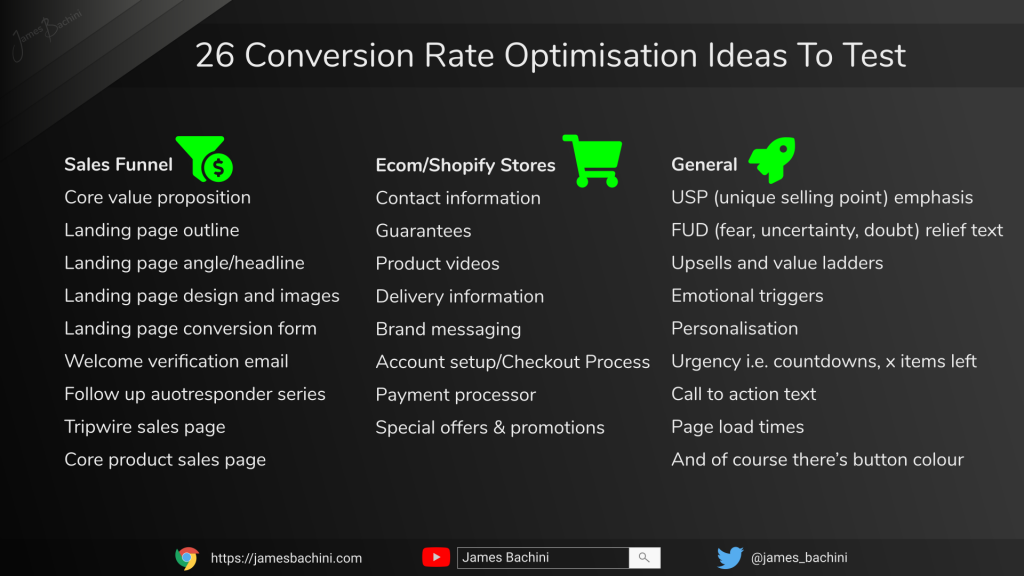
Creating a Conversion Rate Optimisation Plan
Agencies will usually do an assessment and come up with a CRO Plan which will include all the details of the initial tests and hypothesis.
Get 3rd parties to review the website or app and write a summary of what they like and don’t like. This can be people you know or professional UX testers. This is a great way to come up with new hypotheses but also to get qualitative data.
An example test from a basic conversion rate optimisation plan
| Test | Hypothesis | Variations | Conclusion |
| Landing Page1 > CTA Button | Changing sign up button text from the generic “sign up” to more descriptive text will lower resistance and make the offer more appealing. | Sign UpContinueGet AccountJoin TeamGet Offer | 3% CTR increase over original across 10000 clicks with no detrimental effect on KPI’s |
Forming Customer Journey Insights
To be really successful at CRO in the long-term a marketer needs to understand the customer. If you helped design a web page or app then you are in the worst possible position to understand the user journey. We have biases and blindspots that make it very difficult to see the site through fresh eyes as a new user would.
What is intuitive to a web designer most likely isn’t to a computer illiterate first timer. UX testing can help find out where there are opportunities to improve. CRO at an individual test level won’t help much but when you put all the tests together you start to see the bigger picture about how the customer journey works and what is most affecting that conversion throughout the different stages.
By forming insights into our customers we can create better tests, which perform better, increasing conversion rate more and compounding the optimisation across the platform.
The Golden Rule For CRO 💡
Conversion rate optimisation (CRO) is a data driven process which increases the performance of a website or app. Testing requires the tracking of conversion data to validate hypotheses. At its core CRO is still about the customer, while we might need 1000 conversion metrics to decide which button colour is better there is more to be gained from understanding the visitor and creating tests based on their pain points.
This article is part of a free online course where you can learn digital marketing.
If you’ve enjoyed these resources could you help share this content on social media and send it to anyone who you think might benefit from it.
Thank you.


